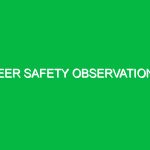In the realm of Health, Safety, and Environment (HSE), understanding and recognizing safe behaviors is paramount. Safe behaviors are actions that prevent accidents, reduce risks, and promote overall well-being in various environments, whether in the workplace, at home, or in public spaces. This article delves into what constitutes safe behaviors, their significance in HSE, the associated hazards, and best practices for fostering a culture of safety. We’ll explore specific regulations that underpin these behaviors and provide actionable insights to implement them effectively.
The Importance of Recognizing Safe Behaviors
Recognizing safe behaviors is vital not only for compliance with regulations but for cultivating a proactive safety culture. When individuals can identify and enact safety-focused actions, the likelihood of accidents diminishes significantly. For instance, a construction site that emphasizes proper lifting techniques and the use of personal protective equipment (PPE) can reduce injury rates. Engaging employees in safety discussions and training can further enhance this recognition and understanding.
Moreover, safe behaviors extend beyond compliance. They contribute to a positive work environment, improve employee morale, and boost productivity. When employees feel safe, they are more likely to perform efficiently and effectively, ultimately benefiting the organization as a whole.
Identifying Hazards Associated with Unsafe Behaviors
Recognizing safe behaviors necessitates an understanding of potential hazards and risks. Hazards can be categorized broadly into physical, chemical, biological, ergonomic, and psychosocial risks.
Physical Hazards
Physical hazards include slips, trips, falls, and equipment-related injuries. For instance, consider a scenario where a worker neglects to wear a hard hat on a construction site. The risk of head injury increases dramatically if tools or materials fall from above. Similarly, wet floors can lead to slips and falls—often avoidable through simple measures like using warning signs and ensuring that spills are cleaned promptly.
Chemical Hazards
Chemical hazards arise from exposure to harmful substances. This could involve inhaling toxic fumes or skin contact with corrosive materials. A real-life example occurred in a manufacturing facility where workers were exposed to a chemical leak due to a faulty valve. The incident underlined the importance of using appropriate PPE and maintaining equipment properly to recognize the signs of unsafe behavior before something drastic occurs.
Biological Hazards
Biological hazards involve exposure to bacteria, viruses, and other pathogens. Healthcare workers, for instance, must practice safe behaviors such as proper hand hygiene and the use of gloves to mitigate the risk of infection. The COVID-19 pandemic highlighted the critical nature of recognizing safe behaviors, such as wearing masks and maintaining social distance, to protect oneself and others.
Ergonomic Hazards
Ergonomic hazards stem from poor workplace design that leads to musculoskeletal disorders. For example, an office worker who sits for extended periods without proper back support may develop chronic pain. Recognizing safe behaviors in this context includes proper seating arrangements, regular breaks, and maintaining good posture, which can significantly reduce discomfort and enhance productivity.
Psychosocial Hazards
Psychosocial hazards relate to stress, harassment, and workplace violence. Recognizing safe behaviors involves creating an environment where employees feel comfortable reporting issues without fear of repercussions. Open communication channels and regular mental health check-ins can foster a supportive culture, enabling workers to address concerns proactively.
Best Practices for Recognizing Safe Behaviors
With a clear understanding of potential hazards, the next step is implementing best practices to foster safe behaviors. Here are several effective strategies:
Regular Training and Education
Training is the cornerstone of recognizing safe behaviors. Regular safety training sessions ensure employees are informed about the latest safety protocols and hazard recognition techniques. Using engaging methods, such as simulations and interactive workshops, can enhance learning retention. For example, a leading engineering firm implemented monthly safety drills that significantly improved their employees’ ability to recognize unsafe conditions.
Effective Communication
Open lines of communication are crucial. Employees should feel empowered to report unsafe behaviors or conditions without fear of backlash. Establishing safety committees or regular meetings can facilitate discussions about safety concerns and encourage sharing of best practices. A personal anecdote: at one recent safety meeting, a worker highlighted a near-miss incident involving unguarded machinery. This discussion led to immediate corrective measures and reinforced the importance of vigilance in recognizing unsafe behaviors.
Utilizing Technology
Technology can enhance safety recognition. Tools such as safety apps and monitoring systems allow for real-time reporting of hazards. For instance, companies can employ wearable devices that alert workers to unsafe conditions, such as excessive exposure to harmful substances or fatigue. These technologies not only help in recognizing safe behaviors but also in tracking compliance with safety protocols.
Encouraging Personal Responsibility
Fostering a culture where employees take personal responsibility for their safety and that of others is essential. Encouraging team members to look out for one another creates a collective commitment to recognizing safe behaviors. For example, a manufacturing plant adopted a peer-to-peer recognition program, rewarding employees who proactively addressed safety concerns. This initiative led to a noticeable decline in incidents and improved overall morale.
Specific Regulations and Standards Governing Safe Behaviors
Understanding the regulatory landscape is essential for recognizing safe behaviors. Various organizations and standards govern HSE practices, including:
Occupational Safety and Health Administration (OSHA)
In the United States, OSHA sets forth regulations to ensure workplace safety. Employers are required to provide a safe working environment, which includes recognizing and addressing unsafe behaviors. Compliance with OSHA standards is not just a legal obligation; it also underscores the organization’s commitment to safety.
International Organization for Standardization (ISO)
The ISO has developed standards, such as ISO 45001, which focuses on occupational health and safety management systems. These standards provide a framework for organizations to improve employee safety, reduce workplace risks, and create better, safer working conditions. Implementing ISO standards can help organizations instill a culture of safety that prioritizes recognizing safe behaviors.
National Institute for Occupational Safety and Health (NIOSH)
NIOSH conducts research and makes recommendations to prevent work-related injury and illness. Their guidelines and resources assist organizations in developing effective safety programs that emphasize recognizing safe behaviors among employees.
Conclusion
Recognizing safe behaviors is a critical component of the Health, Safety, and Environment domain. By understanding the risks associated with unsafe behaviors and implementing best practices, organizations can foster a culture of safety that benefits everyone involved. Regular training, effective communication, the use of technology, and a commitment to personal responsibility are all instrumental in this process. Coupled with adherence to established regulations and standards, recognizing safe behaviors can lead to a significant reduction in accidents and a healthier, more productive workplace.
As we move forward in an ever-evolving global landscape, let us remain vigilant and proactive in recognizing safe behaviors. By doing so, we not only protect ourselves but also create a safer environment for everyone.


